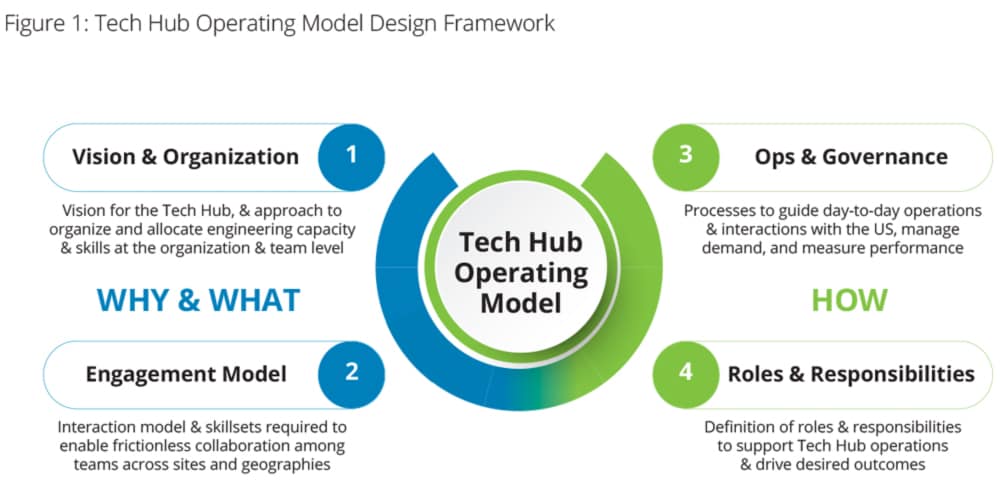Nearshoring software engineering tech talent has been saved

Perspectives
Nearshoring software engineering tech talent
Advantages of offshore alternatives
Companies are increasingly considering nearshoring to augment traditional on- and offshore software engineering models. Latin America, in particular, presents an attractive opportunity to acquire and scale tech talent. Discover how you can start, scale, and make the most of your nearshore options.
The case for international software engineering hubs
Software delivery is more globalized than ever before. Moving beyond the traditional use of offshore technology hubs to support internal IT and provide shared services, companies are increasingly relying on globalized models to drive innovation and new product development. Deloitte has been approached by clients across industries—including technology, financial services, biopharmaceuticals, food service, and retail—asking how they can extend their software product engineering teams beyond US borders to grow the footprint of their tech talent.
Customers today demand innovative product features that require an ability to rapidly deliver high-quality software while maintaining a focus on margins. As such, two macro trends are pressuring companies to look beyond current geographies for global software engineering talent: 1) challenges accessing onshore talent and 2) accelerated customer demands for digital experiences.
First, software engineering talent in the United States has been expensive and in high demand for a long time. The current median salary of a US software developer is twice as expensive as the global median salary for the same position.1
Although approximately 95,000 software engineers have been recently cut by US tech companies,2 these same organizations have added about 875,000 jobs since 2019; meaning the layoffs represent only 10% of the broad workforce expansion over the past four years.3 Furthermore, cost pressures and an uncertain economic outlook are causing leaders to tighten business and IT operations budgets.
Still, more than 50% of leaders in a 2023 CEO survey said that investing in digital and technology capabilities continues to be a top priority.4 Moreover, finding cloud-native tech talent has been a challenge in the United States for more than two years; according to 2020 research, more than 90% of IT leaders plan to expand their modern software engineering and cloud environments, yet 80% say inadequate employee skills are holding them back.5 We have most recently seen clients dedicate international tech centers to specialized functions for improved automation and efficiency. We expect automation and process improvement to continue at the top of leaders’ priority stack; engineering talent will be key for their success.
Second, customers are demanding enhanced digital experiences powered by software-based products and platforms across a wider range of industries, making technology capabilities core and foundational to their business. For example, in the quick-service restaurant industry, many companies are citing digital channels as a key growth driver. One American fast-food conglomerate recorded a 25% ($4.4 billion) sales increase from 2020 to 2021 from its brand applications and food-delivery partners; in 2022, digital sales represented more than 50% of the company’s total revenue growth.6 Similarly, the fixed video surveillance industry has shifted from being hardware-centered to cloud-centered as users demand anywhere, anytime access to surveillance footage and analytics. In its Q4 2022 report, a leading video equipment and services provider reported that cloud and artificial intelligence (AI) are driving and will continue to drive growth, with an anticipated 25% year-over-year (YoY) increase in software-related revenue.7 We expect the demand for digital experiences to continue to challenge new industries to build digital product teams.
The challenges of domestic cost pressures and limited talent supply, coupled with the growing demand for digital experiences, create an imperative for US companies to look internationally to support traditional IT functions and digital product development. Increasingly, out of the offshore alternatives, there is an attractive option close to home—Latin America.
The case for Latin America nearshoring
Recent macro trends are prompting US companies to consider Latin America (LATAM) as a favorable location for nearshore software development. LATAM is home to a strong and growing base of well-educated software engineers experienced in cloud-native technologies. The region’s two largest markets, Brazil and Mexico, are currently home to more than 2.2 million software engineering professionals and are graduating more than 350,000 new engineering students every year.8 We have seen major international employers—including global technology, retail and consumer goods, banking, manufacturing, and automotive companies—take action to establish an engineering presence in LATAM markets such as Mexico, Colombia, Costa Rica, and Brazil. These employers are seeking cloud-native talent ranging from full-stack developers to more niche skill sets such as machine learning engineering. Recruiting process outsourcer CodersLink reports that more than 50% of engineers in Mexico qualify themselves within cloud-native roles: full-stack, back-end, front-end, cloud, mobile engineers, among others.9 We expect the current base of software engineers will continue to grow steadily, making LATAM an appealing location to harness software engineering talent.
In addition to the growing base of talent in Latin America, nearshoring has additional benefits relative to other operating models. As opposed to teams distributed between the United States and more traditional offshore locations in Asia, nearshoring lends itself to real-time collaboration. Our clients have intentionally identified scope that benefits from real-time interaction between onshore teams and international teams, such as front-end development, real-time data pipeline work, and interactions between machine learning engineers and data scientists. From a talent experience standpoint, a nearshore model can help eliminate the time-zone fatigue inherent in coordinating handovers during daily endpoints.
Initiating operations in Latin America can be a daunting task with distinct complexities compared to other global markets. Making an intelligent expansion play involves knowing how to select the right location, attract the right local tech talent, and choose the right operating model.
Select the right location
Multiple factors are contributing to US companies’ desire to move beyond long-used, low-cost Asian markets. Increased focus on work/life balance and wellness in today’s post-COVID-19 pandemic environment has magnified the demand for time-zone-aligned resources that enable increased collaboration and avoid fatigue from morning and evening handovers between agile teams.
Latin America has been a significant beneficiary of this trend. The region long has had strong technology capabilities—Brazil, Argentina, Chile, Colombia, and Mexico all boast large technology talent pools—but it recently has been seeing a rapid acceleration in interest as both captive operations and service providers seek to expand their global footprint. Couple this with finite availability of candidates with strong English language skills, and the immediate opportunity to capitalize on this opportunity is clear.
Location matters, but not all locations are created equal. When strategizing where to nearshore in LATAM, companies should consider the following components: tech talent supply, English language capabilities, competitive landscape, strength and supply of the graduate pipeline, risk (security, natural disaster, economic), business climate, physical proximity percentage access, physical infrastructure, and operating cost.
Attract the right local talent
After selecting from among target markets, the next step in creating a nearshore tech hub is developing a strategy to attract, recruit, develop, and retain top tech talent. The following insights may aid local talent recruitment and retention efforts:
The local talent market may be familiar with a company’s brand, but the organization itself may not fully understand why or to what extent. Focusing on building brand awareness provides an opportunity to craft a positive brand image and perception in the region.
Entering a new market requires that organizations develop a holistic plan to secure top tech talent at scale and in alignment with the overall market entry strategy. Recruitment and onboarding processes should be localized and personalized to deliver a high-touch and competitive acclimation experience that aligns with the brand and EVP. This begins with establishing an aggressive and realistic ramp-up plan that includes YoY workforce targets (for both experienced and early career talent), leadership ratios, recruitment service delivery leverage models, and resource requirements to effectively scale the workforce.
A 2022 report suggests that tech candidates regard career path and upskilling as the leading driver of employee satisfaction, with 70% of tech professionals in Mexico rating training and certifications as the most valuable benefit offered by their companies.10 A 2022 global survey of CIOs and IT decision-makers revealed that 93% say the Great Resignation has made it more difficult for IT teams to retain skilled developers, and 86% say it has become more difficult to recruit them in the past two years,11 raising significant hurdles for companies to meet productivity targets. Companies should be proactive about crafting logical, predictable, and merit-based career progression plans for associates that tie to a fair performance management process.
Company leaders should be intentional when designing the nearshore workplace to ensure it reflects the company’s brand values and commitment to the local market. A positive workplace culture can help increase employees’ organizational affinity and productivity. We suggest frontloading experience workshops with early hires to define cultural pillars and ways of working that capture the company’s long-term objectives globally.
Choose the right operating model
In addition to location selection and talent acquisition strategies, it is also important that a company considers what type of operating model it should use to manage its nearshore tech hub operations. In our experience, a mature operating model encompasses four categories: vision and organization, engagement model, ops and governance, and roles and responsibilities (figure 1).

Defining the tech hub’s operating model starts by establishing the overall vision for the hub’s capabilities and how the company will organize to productively deliver these capabilities.
Taking a structured approach to nearshoring
The journey of designing, launching, and successfully scaling an international tech hub can be lengthy and difficult. However, given the accelerated pace of digital adoption across all industries and the ongoing need to find high-quality tech talent, we anticipate that companies will continue to consider nearshore expansion and that LATAM is an attractive option. By strategically addressing location selection, talent acquisition, and operating model considerations, companies can take a structured approach to launching and scaling nearshore tech hubs and realize the dual benefits of cost savings and access to a broad, high-quality talent pool.
Endnotes
1 Stack Overflow, Stack Overflow Developer Survey 2021, 2021.
2 Elisabeth Buchwald and Javier Zarracina, “Massive tech company layoffs look ugly. But it may not be as bad as you think.,” USA Today, updated February 9, 2023.
3 Alex Irwin-Hunt, “Big tech layoffs barely touch pandemic-era hiring,” fDi Intelligence, February 15, 2023.
4 GLG, The GLG CEO Survey: 2023, January 2023.
5 A Cloud Guru, State of cloud learning report 2020, 2020.
6 Yum! Brands, “Form 10-K,” February 23, 2022.
7 Motorola Solutions, “Form 10-K,” 2022.
8 ILO, OECD, Gartner, 2021–2022 data.
9 CodersLink, Tech salaries report 2022, 2022; CodersLink, “Engineering positions density in Mexico by role,“ May 4, 2022.
10 Hireline, IT labor market report 2022, 2022.
11 Salesforce, “New research shows how to keep developers happy amid the ‘Great Resignation’,” April 13, 2022.
Get in touch
Recommendations
Software Engineering Services
Deloitte’s modern software engineering, product innovation, and domain experience are at the leading edge of business to help you create new enterprise value.
Location Strategy
Location and footprint matters







